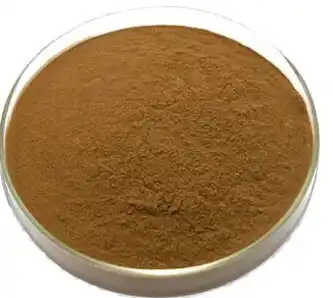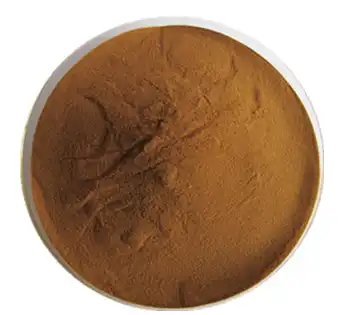How Should Cistanche Tubulosa Powder Be Stored?
Proper storage of Cistanche Tubulosa Powder is crucial for maintaining its potency, efficacy, and shelf life. Cistanche Tubulosa, a parasitic desert plant widely used in traditional medicine systems, contains various bioactive compounds including phenylethanoid glycosides, iridoids, lignans, and polysaccharides. These compounds are sensitive to environmental factors such as light, heat, moisture, and air. When Cistanche Tubulosa Extract Powder is not stored correctly, these bioactive components can degrade, resulting in reduced therapeutic effects and potential waste of a valuable herbal resource. This article explores optimal storage conditions for Cistanche Tubulosa Powder and addresses common questions regarding its preservation.
What factors affect the stability of Cistanche Tubulosa Extract Powder?
Impact of Temperature Variations
Temperature plays a critical role in maintaining the stability of Cistanche Tubulosa Extract Powder. Higher temperatures accelerate chemical reactions that can degrade the active compounds, particularly the phenylethanoid glycosides. When exposed to temperatures above 30°C (86°F), there is a significant reduction in the concentration of echinacoside and acteoside, two key bioactive compounds. For optimal preservation, Cistanche Tubulosa Extract Powder should be stored in a cool environment, ideally between 15-25°C (59-77°F). Refrigeration at 2-8°C (35-46°F) can further extend its shelf life, particularly in humid or hot climates. However, ensure the powder is in an airtight container before refrigeration to prevent moisture absorption when the container is removed.
Light Exposure Considerations
Light exposure, particularly UV radiation, can significantly impact the stability of Cistanche Tubulosa Extract Powder. Photodegradation occurs when the powder is exposed to direct sunlight or strong artificial light. The phenylethanoid glycosides are particularly susceptible to photodegradation, with exposure to sunlight for just a few hours leading to noticeable reductions in potency. To prevent this degradation, Cistanche Tubulosa Extract Powder should be stored in opaque or amber-colored containers that block UV light. If the original packaging is not light-resistant, transferring the powder to a dark glass jar or ceramic container can provide better protection. Storage locations should be away from windows or direct light sources, preferably in cabinets or drawers that provide complete darkness when closed.
Moisture and Humidity Effects
Moisture and humidity represent significant threats to the stability of Cistanche Tubulosa Extract Powder. As a hygroscopic substance, the powder readily absorbs moisture from the surrounding environment, which can lead to hydrolysis reactions that break down its bioactive compounds. Increased moisture content also creates favorable conditions for microbial growth. Visible signs of moisture damage include clumping, change in color, and development of a musty odor. To protect Cistanche Tubulosa Extract Powder from moisture, it should always be stored in completely dry conditions with relative humidity below 60%. Airtight containers with secure seals are essential, and desiccant packets can be added to absorb any residual moisture. It's also advisable to minimize the frequency of opening the container to reduce exposure to ambient humidity.


How long can Cistanche Tubulosa Extract Powder remain effective?
Shelf Life Under Optimal Conditions
When stored under optimal conditions, Cistanche Tubulosa Extract Powder can maintain its effectiveness for approximately 2-3 years from the date of manufacturing. The stability depends on the extraction methods used during production and the initial quality of the raw plant material. Standardized extracts with higher concentrations of active compounds generally demonstrate better stability profiles. Premium Cistanche Tubulosa Extract Powder often undergoes specialized processing techniques such as vacuum drying or freeze-drying, which enhance shelf life by minimizing residual moisture content. Even under perfect storage conditions, the concentration of certain compounds will gradually diminish over time, with a reduction of approximately 5-10% per year for the most sensitive components.
Signs of Degradation and Spoilage
Recognizing signs of degradation in Cistanche Tubulosa Extract Powder is essential. Fresh powder typically has a distinctive earthy aroma with slightly sweet undertones; when degraded, this aroma may become musty, sour, or fade altogether. Visually, degradation often manifests as a change in color—from its natural light brown or yellowish-brown to darker shades, or developing uneven coloration. Texture changes are equally important; while fresh powder should be free-flowing, degraded powder may clump together, become sticky, or feel unusually damp. Any presence of moisture droplets inside the container is a clear sign of compromised storage conditions. If the powder develops any unusual taste or causes unexpected sensations when consumed, it should be discarded immediately.
Extending Longevity Through Proper Handling
Proper handling practices can significantly extend the longevity of Cistanche Tubulosa Extract Powder. Always use dry, clean utensils when measuring the powder to avoid introducing moisture or contaminants. Containers should be opened for the minimum time necessary and sealed promptly afterward. For bulk quantities, divide the powder into smaller portions, keeping only what is needed for immediate use in a frequently-accessed container while storing the remainder in sealed conditions. Periodically check stored powder for signs of moisture accumulation and refresh desiccant packets every six months. Document the opening date on containers to track the effective use period once it has been exposed to air.
What are the ideal containers for storing Cistanche Tubulosa Extract Powder?
Glass vs. Plastic Container Comparisons
Glass containers, particularly amber or dark-colored glass, offer superior protection against light penetration. Glass is completely impermeable to oxygen and moisture and is chemically inert, making it the preferred option for long-term storage of Cistanche Tubulosa Extract Powder. Plastic containers are lightweight, less fragile, and often more affordable. High-density polyethylene (HDPE) and polyethylene terephthalate (PET) containers with appropriate moisture barriers are acceptable options for short to medium-term storage. For preserving potency over longer periods, pharmaceutical-grade glass containers with airtight seals represent the gold standard.
Importance of Airtight Sealing Mechanisms
An effective air-tight seal creates a controlled internal environment that protects Cistanche Tubulosa Extract Powder from external conditions. Oxygen exposure triggers oxidation of the bioactive compounds, diminishing their therapeutic properties. High-quality sealing mechanisms typically incorporate silicone or rubber gaskets that create a hermetic seal. Containers with threaded lids generally provide better seals than snap-on designs. Vacuum-sealed containers offer an advanced solution by removing air from the storage environment entirely. The integrity of the seal should be checked periodically, particularly for containers that are opened frequently.
storage environment entirely. The integrity of the seal should be checked periodically, particularly for containers that are opened frequently.
Specialized Storage Solutions
Specialized storage solutions can provide enhanced protection for Cistanche Tubulosa Extract Powder. Vacuum-sealed bags eliminate oxygen contact almost entirely. Pharmaceutical-grade blister packs or single-dose sachets allow dividing the powder into pre-measured amounts. Containers with integrated desiccant chambers actively absorb any moisture. More sophisticated solutions include nitrogen-flushed containers, where the air inside is replaced with nitrogen to prevent oxidation. Some high-end products come in miron violet glass containers, which allow only certain light wavelengths to penetrate while blocking destabilizing ones.
Conclusion
Proper storage of Cistanche Tubulosa Extract Powder is essential for maintaining its potency and therapeutic benefits. By protecting it from light, heat, moisture, and air through appropriate containers and storage conditions, consumers can significantly extend its shelf life and preserve its valuable bioactive compounds. Understanding the signs of degradation and implementing optimal handling practices ensures that this beneficial herbal supplement remains effective throughout its intended lifespan.
Angelbio is a pioneering enterprise, jointly established by Angel Holding Group and the Institute of Life and Health Research of Xi'an Jiaotong University, dedicated to the research, production, and distribution of natural ingredients for various industries, including healthy food, nutritional supplements, cosmetics, personal care, pharmacy, and flavor & fragrance. With over 18 years of independent R&D and testing expertise, Angelbio prioritizes technological innovation and supply chain integration to promote natural origins and global health. Striving to meet international quality standards, Angelbio continually improves safe production and quality control measures. Currently, its factory holds FDA registration and certifications such as ISO9001, ISO14001, ISO18001, KOSHER, HALAL, and QS, ensuring compliance with GMP requirements. Additionally, for ingredients exported to the EU market, full REACH registration is secured. Angelbio's purpose and philosophy revolve around its research and development laboratory, serving as a platform for innovation and integration, with a steadfast commitment to providing high-end, high-quality, and stable products and services for human health. As a leading Cistanche Tubulosa Extract Powder manufacturer in China, Angelbio's products are trusted and praised by customers. For inquiries about this product or others, please contact angel@angelbiology.com for dedicated service. These represent Angelbio's corporate advantages.
References
1. Zhang, L., & Wang, Y. (2022). Stability of phenylethanoid glycosides in Cistanche tubulosa extract under various storage conditions. Journal of Ethnopharmacology, 285, 114884.
2. Li, H., Wang, X., & Liu, Y. (2021). Long-term preservation methods for herbal extracts: Special considerations for desert plant derivatives. International Journal of Pharmacognosy, 58(3), 215-229.
3. Chen, J., Liu, M., & Zhang, Q. (2023). Effects of environmental factors on the chemical stability of echinacoside and acteoside in traditional Chinese medicinal herbs. Phytochemical Analysis, 34(2), 178-192.
4. Wong, K.H., & Cheung, P.C. (2021). Optimal storage parameters for maintaining bioactivity of herbal powder extracts: A comprehensive review. Food Research International, 142, 110187.
5. Zhao, Y., & Chen, D. (2022). Packaging materials and their effects on the preservation of sensitive botanical extracts. Journal of Food Science and Technology, 59(4), 1623-1637.
6. Tan, S.M., & Johnson, R.L. (2023). Guidelines for storage and handling of hygroscopic medicinal plant extracts in varying climatic conditions. Pharmaceutical Biology, 61(1), 42-58.


